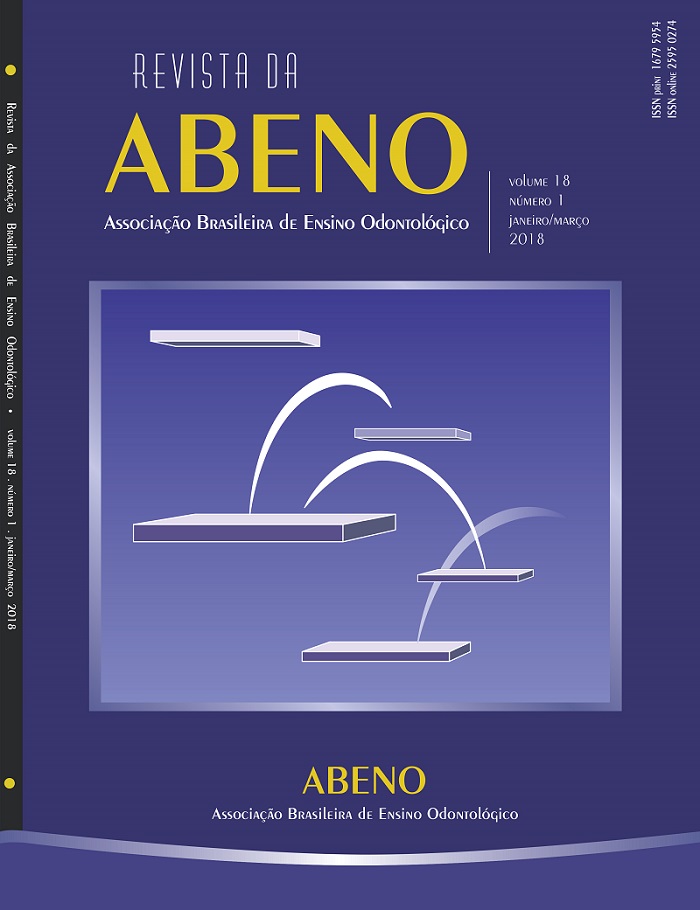Child Abuse from the perspective of Dental Students
DOI:
https://doi.org/10.30979/rev.abeno.v18i1.394Keywords:
Child Abuse. Dental Education. Dental Students.Abstract
Violence against children does not occur only in developing countries and happens so frequently that it is sometimes trivialized. Children and adolescents are easy targets for acts of violence because they are frail and dependent. The aim of this study was to verify the knowledge of dental students, by means of questionnaires, regarding maltreatment in childhood and adolescence. Application of a questionnaire to dental students enrolled in the Dentistry course of the University of Planalto Catarinense and Federal University of Espírito Santo, with an approach to the concept and characteristics of maltreatment, conduct when faced with this, knowledge about the Child and Adolescent Statute (CAS), and the dentist's responsibility about notification of maltreatment. The data were analyzed by means of descriptive statistics in absolute frequencies and percentages. In the research, 363 students participated. Of these 265 (73%) were of the female gender, and the mean age was 21.38 years (± 3.01). During the undergraduate period, 34,9% of the students affirmed they had not received any information about maltreatment in childhood and adolescence, and despite this, the majority (86,8%) felt they were capable of diagnosing cases of maltreatment. The students mentioned alterations in soft tissues (65,3%), dental traumas (48,5%), as characteristics related to maltreatment. Regarding making a complaint/pressing charges, only 30,3% mentioned the Guardian Council and 35,3% knew the meaning of "CAS". It was observed that students from the two Institutions could identify signs of maltreatment, but they needed more information about the notification of these events.
Downloads
References
Pires ALD, Miyazaki MCOS. Maus-tratos contra crianças e adolescentes: revisão da literatura para profissionais da saúde. Arq Ciênc Saúde. 2005;(1):42-9.
Ramos MLCO, Silva AL. Estudo sobre a violência doméstica contra a criança em Unidades Básicas de Saúde do município de São Paulo, Brasil. Saúde Soc. 2011;20(1):136-46.
UNICEF 2012. Infância e adolescência no Brasil. [Acesso em: 29 fev. 2016]. Disponível em: http://www.unicef.org/brazil/pt/activitie.
Secretaria Nacional de Promoção dos Direitos da Criança e do Adolescente. [Acesso em: 28 fev. 2016]. Disponível em http://www.direitos dacrianca.org.br/midiateca/publicacoes/relatorio-geral-do-disque-100-2010.
Brasil. Lei no.8069, de 13 de julho de 1990. Dispõe sobre o Estatuto da Criança e do Adolescente e dá outras providências. [Acesso em: 2 fev. 2016]. Disponível em http://www.pla nalto.gov.br/ccivil/LEIS/L8069.htm.
Azevedo MS, Goettems ML, Brito A, Possebon AP, Domingues J, Demarco FF. Child maltreatment: a survey of dentists in southern Brazil. Braz Oral Res. 2012; 26(1):5-11.
Massoni ACLT, Ferreira AMB, Aragão AKR, Menezes VAC, Colares V. Aspectos orofaciais dos maus-tratos infantis e da negligência odontológica. Ciênc Saúde Coletiva 2010;15(2): 403-10.
Greco R. Código Penal Comentado. 10 ed. Niterói: Impetus; 2016. 1263p.
Matos FZM, Borges AH, Mamede Neto I, Rezende CD, Silva K, Pedro FLM, et al. Avaliação do conhecimento dos alunos de graduação em odontologia x cirurgiões-dentistas no diagnóstico de maus-tratos às crianças. Rev Odontol Bras Central. 2013;22(63):153-7.
Serpa EM, Ramos AAS. Percepção dos maus tratos infantis pelos estudantes de odontologia da UFPB. Int J Dent. 2011;10(4):234-41.
Sousa GFP, de Carvalho MMP, Granville-Garcia AF, Gomes MNC, Ferreira JMS. Conhecimento de acadêmicos em odontologia sobre maus-tratos infantis. Odonto. 2012; 20(40):109-17.
Thomas JE, Straffon L, Inglehart MR. Knowledge and professional experiences concerning child abuse: an analysis of provider and student responses. Ped Dent. 2006; 28(5):438-44.
Gomes LS, Pinto TCA, Costa EMMB, Ferreira JMS, Cavalcanti SDLB, Granville-Garcia AF. Percepção dos acadêmicos de odontologia sobre os maus tratos na infância. Odont Clin-Cient. 2011;10(1):73-8.
Brasil. Constituição da República Federativa do Brasil de 1988. [Acesso em: 2 fev. 2016]. Disponível em http://www.planalto.gov.br/ ccivil_03/Constituicao.
Kellogg ND. Evaluation of suspected child physical abuse. Pediatrics. 2007;119(6):1232-41.
Manea S, Favero GA, Stellini E, Romoli L, Mazzucato M, Facchin P. Dentists’ perceptions, attitudes, knowledge, and experience about child abuse and neglect in Northeast Italy. J Clin Ped Dent. 2007;32(1):19-25.
Cavalcanti AL. Prevalence and characteristics of injuries to the head and orofacial region in physically abused children and adolescents--a retrospective study in a city of the Northeast of Brazil. Dent Traumatol. 2010; 26(2):149-53.
Cavalcanti AL. Abuso infantil: protocolo de atendimento odontológico. Rev Bras Odontol. 2001;58(6):378-80.
Cavalcanti AL. Manifestações físicas do abuso infantil: aspectos de interesse odontológico. Rev Paul Odontol. 2003; 25(5):16-9.
Avon, SL. Forensic Odontology: the roles and responsibilities of the dentist. J Can Dent Assoc. 2004;70(7):453-8.
Vieira ELR, Katz CRT, Colares V. Indicadores de maus-tratos em crianças e adolescentes para uso na prática da odontopediatria. Odont Clin-Cient. 2008; 7(2):113-8.
Associação Brasileira Multiprofissional de Proteção à Infância e à Adolescência/ ABRAPIA. Maus-tratos contra crianças e adolescentes: proteção e prevenção. Guia de orientação para profissionais da saúde. Rio de Janeiro. 2001.
American Academy of Pediatric Dentistry. Guideline on oral and dental aspects of child abuse and neglect. Ped Dent. 2013/2014; 35(6):163-6.
Ramos Nitani ON, Bonassi SM. Abuso sexual contra crianças: diagnóstico psicológico pericial sob o olhar psicanalítico. An Sciencult. 2011;1(3). [Acesso em: 2 fev. 2016]. Disponível em http://anaisonline.uems.br/ index.php/sciencult/article/view/3321/3294.
Downloads
Published
How to Cite
Issue
Section
License
Autores que publicam nesta revista concordam com os seguintes termos:
a) Autores mantém os direitos autorais e concedem à revista o direito de primeira publicação, com o trabalho simultaneamente licenciado sob a Licença Creative Commons Attribution que permite o compartilhamento do trabalho com reconhecimento da autoria e publicação inicial nesta revista.
b) Autores têm autorização para assumir contratos adicionais separadamente, para distribuição não-exclusiva da versão do trabalho publicada nesta revista (ex.: publicar em repositório institucional ou como capítulo de livro), com reconhecimento de autoria e publicação inicial nesta revista.
c) Autores têm permissão e são estimulados a publicar e distribuir seu trabalho online (ex.: em repositórios institucionais ou na sua página pessoal) a qualquer ponto antes ou durante o processo editorial, já que isso pode gerar alterações produtivas, bem como aumentar o impacto e a citação do trabalho publicado (Veja O Efeito do Acesso Livre).






